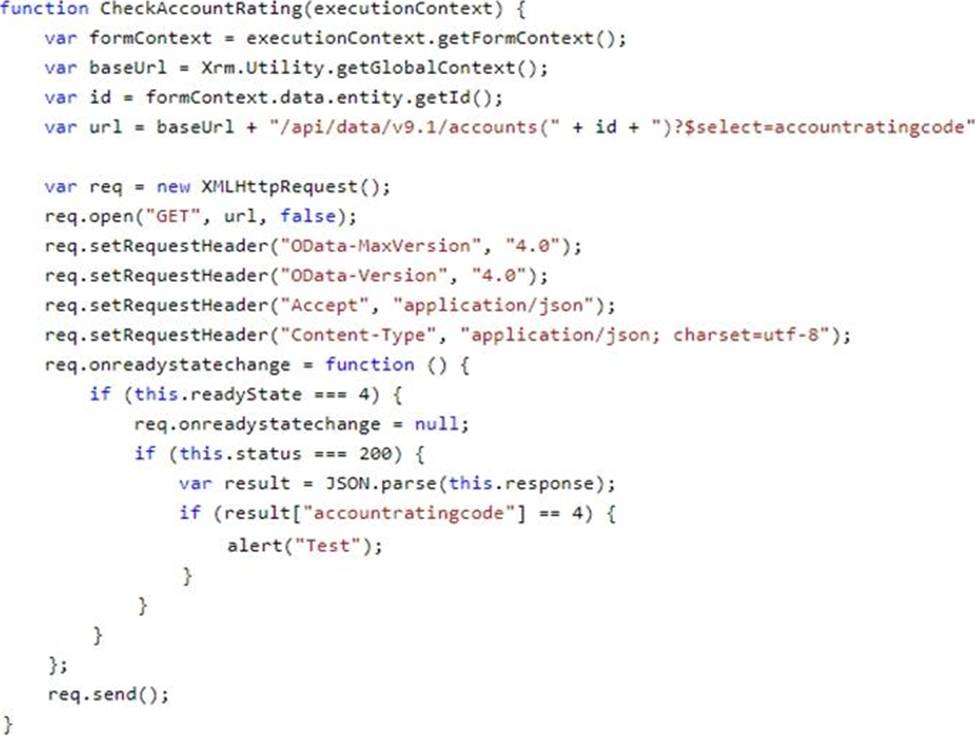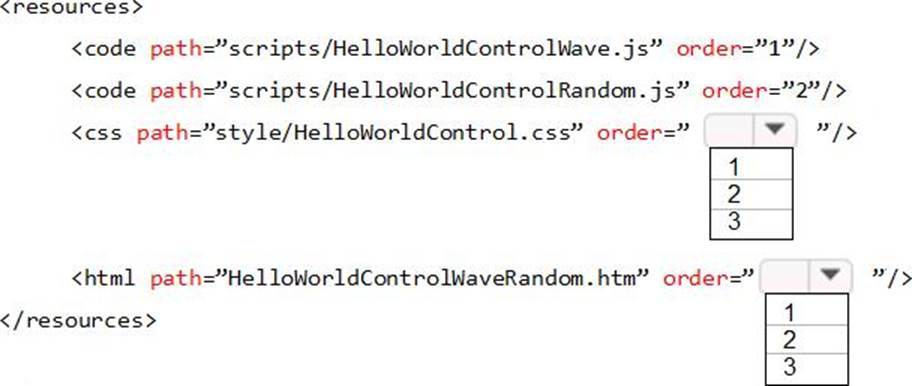Practice Free PL-400 Exam Online Questions
You need to handle errors in UpdateRecord.js.
Which code segment should you add at line UR06?
- A . catch(error) {
alert("Caught error: " + error.message);} - B . Exception exception = Server.GetLastError() ;
if(exception != null)} - C . catch(exception e){
console.writeline(e)} - D . function (error){
console.log(error.message)}
A
Explanation:
https://docs.microsoft.com/en-us/powerapps/developer/model-driven-apps/clientapi/reference/xrm-webapi/updaterecord
HOTSPOT
You develop the following JavaScript code for a web resource that will be used in a model-driven app.

For each of the following statements, select Yes if the statement is true. Otherwise, select No. NOTE: Each correct selection is worth one point.


Explanation:
Box 1: Yes
Problem patterns: Web-use-async
There are multiple ways to interact with the server or request resources.
Common approaches that allow for synchronous communications include the following (These scenarios should be avoided.):
✑ Usage of the XMLHttpRequest object passing in false for the value of the async parameter for the open function call
var requestXhr = new XMLHttpRequest();
// Explicitly setting the async parameter to false or supplying a variable with a value of false will force this as a synchronous call. requestXhr.open(‘GET’, ‘/test/test.txt’, false);
Box 2: No
=== – Strict Equality Comparison is already used in the code.
Box 3: No
No debugger statement in the code, so web-remove-debug-script (avoid including debug script in non-development environments) does not apply.
Reference:
https://docs.microsoft.com/sr-cyrl-rs/powerapps/developer/model-driven-apps/best-practices/business-logic/interact-http-https-resources-asynchronously
https://developer.mozilla.org/en-US/docs/Web/JavaScript/Reference/Operators/Strict_equality
A company implementsDynamics 365 Customer Service. The company deploys synchronous plug-ins for the PreOperation and PostOperation stages on create and for the PostOperation stage on update for processing different case type.
Users experience errors when updating cases. The plug-in trace log files show that the PostOperation plug-in update of case times out after two minutes.
You perform basic testing and discover that this plug-in is triggered on every update of a case. You examine the code and discover that the plug-in retrieves all columns for the updated case record performing its work.
You need to reduce the number of errors. You need to achieve this goal with the test amount of changes.
Solution: In the Plug-in Registration tool, set filtering attributes on the plug-in to only Case Type filed.
Does the solution meet the goal?
- A . Yes
- B . No
DRAG DROP
A company is developing a Microsoft Dataverse plug-in. The plug-in must create a follow-up task for a new account
You add the code that receives context(IPIuginExecutionContext) and service(IOrganizationService). You need to create the remaining code to insert the follow-up task.
Which three code blocks should you use in sequence? To answer, move the appropriate code sequences from the list of sequences to the answer area and arrange them in the correct order.


You deploy a Power Platform plug-in to a production environment. The plug-in code contains detailed tracing information. You are a member of the Environment Maker security role for the environment.
Users report unexpected results when they interact with confidential data by using the plug-in. You confirm that the plug-in works without errors in a development environment.
You need to investigate the root cause of the plug-in errors.
What should you do?
- A . Send a PUT request to enable plug-in tracing for the production environment.
- B . Send a GET request to retrieve the plugintracelogs records.
- C . Install Plug-in profiler in the production environment by using the Plug-in Registration tool.
- D . Reproduce and capture the errors, then debug from Visual Studio.
C
Explanation:
Plug-in profiler is a solution that you can install on your environment that enables you to capture the execution context of a plug-in and then use that data to re-play the event within Visual Studio while debugging.
There are two tools available from which to run the Plug-in Profiler:
the Plug-in Registration Tool and Power Platform Tools for Visual Studio.
Reference: https://docs.microsoft.com/en-us/powerapps/developer/data-platform/tutorial-debug-plug-in
HOTSPOT
You need to complete a PowerApps component framework (PCF) control.
How should you define the order in the manifest? To answer, select the appropriate options in the answer area. NOTE: Each correct selection is worth one point.


Explanation:
The order property specifies the order of a flexible item relative to the rest of the flexible items inside the same container.
Reference: https://www.w3schools.com/jsref/prop_style_order.asp
You are deploying a Power Apps app that uses the custom connector for ServiceNow.
The app loads very slowly for some users. You determine that all records from ServiceNow are being retrieved for every user.
The app must load only incidents that are assigned to each user.
You need to limit the number of records that the connector returns.
What should you do?
- A . Apply a Lifecycle Services asset scope
- B . Apply a business process flow
- C . Apply the Azure APIM parameter
- D . Apply a connector policy template
D
Explanation:
You can configure policy templates for custom connectors. Policies allow you to modify the behavior of a custom connector at runtime. You can use policies to perform data conversion, route requests, set parameter values, and more. You can configure policies directly in the custom connector API properties file before import, or you can do it from the maker portal in the custom connector designer by applying policy templates.
Note: ServiceNow Action: GetRecords
Summary: List Records
Description: Gets records of a certain ServiceNow object type like ‘Incidents’ Syntax:ServiceNow.GetRecords (string tableType, [advanced][Optional]boolean sysparm_display_value, [advanced][Optional]boolean sysparm_exclude_reference_link, [advanced][Optional]string sysparm_query, [advanced][Optional]integer sysparm_limit, [advanced][Optional]integer sysparm_offset)
Reference:
https://docs.microsoft.com/en-us/learn/modules/policy-templates-custom-connectors/h
ttps://www.carlosag.net/PowerApps/Connectors/ServiceNow
You need to resolve CustomerB’s issues with the check-in application.
Which two options can you use? Each correct answer presents a complete solution. NOTE: Each correct selection is worth one point.
- A . LookUp to Filter
- B . Filter to LookUp
- C . Search to LookUp
- D . LookUp to Search
AD
Explanation:
CustomerB reports that the check-in app returned only one search result for their last name, which is not the correct name.
The Filter function finds records in a table that satisfy a formula. Use Filter to find a set of records that match one or more criteria and to discard those that don’t.
The LookUp function finds the first record in a table that satisfies a formula. Use LookUp to find a single record that matches one or more criteria.
The Search function finds records in a table that contain a string in one of their columns.
Reference: https://docs.microsoft.com/en-us/powerapps/maker/canvas-apps/functions/function-filter-lookup
You need to create the eligibility assessment app.
Which command should you run?
- A . pac application install
- B . pac solution init
- C . pac plugin init
- D . pac pcf init
A company is testing a Microsoft Dataverse plug-in in an environment. The plug-in works in post-operation mode and performs the update of the Account entity.
During testing, a user observes that the plug-in unintentionally triggers a synchronous third-party ISV plug-in.
You need to modify the system design to avoid unwanted triggering of the third-party plug-in.
What should you do?
- A . Disable the existing third-party plug-in by using the Plug-in Registration Tool.
- B . Use UpdateRequest with the BypassCustomPluginExecution parameter and Execute method of the Organization service.
- C . Update the code of the third-party ISV plug-in to ignore updates caused by the new plug-in.
- D . Update the code of the new plug-in to use InputParameters of Plugin Execution Context.
